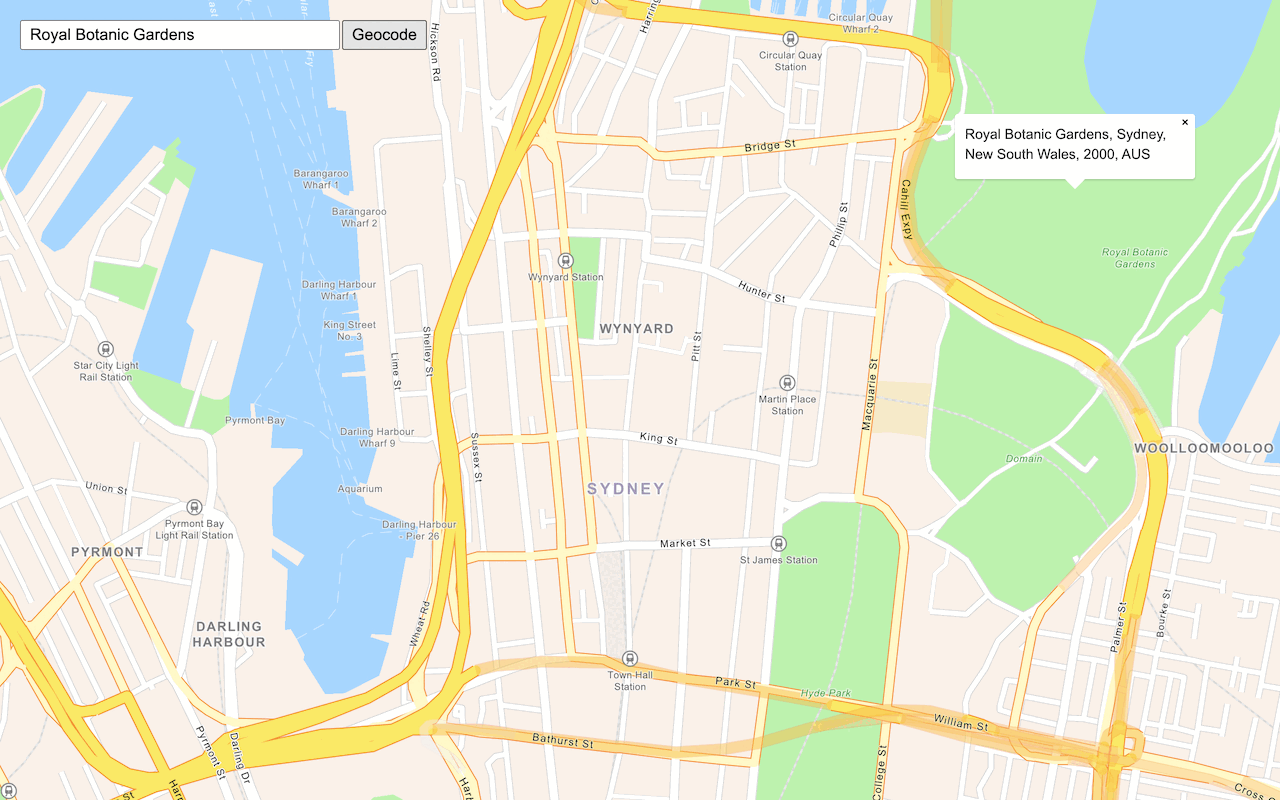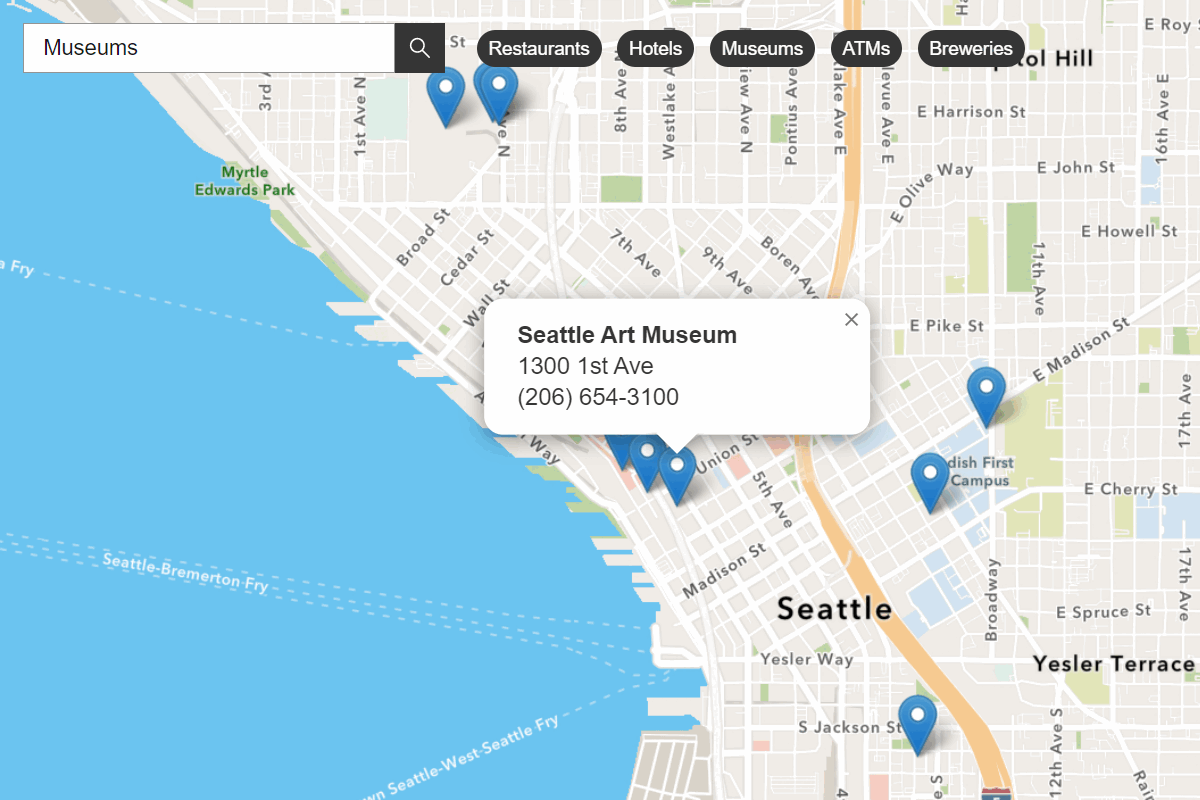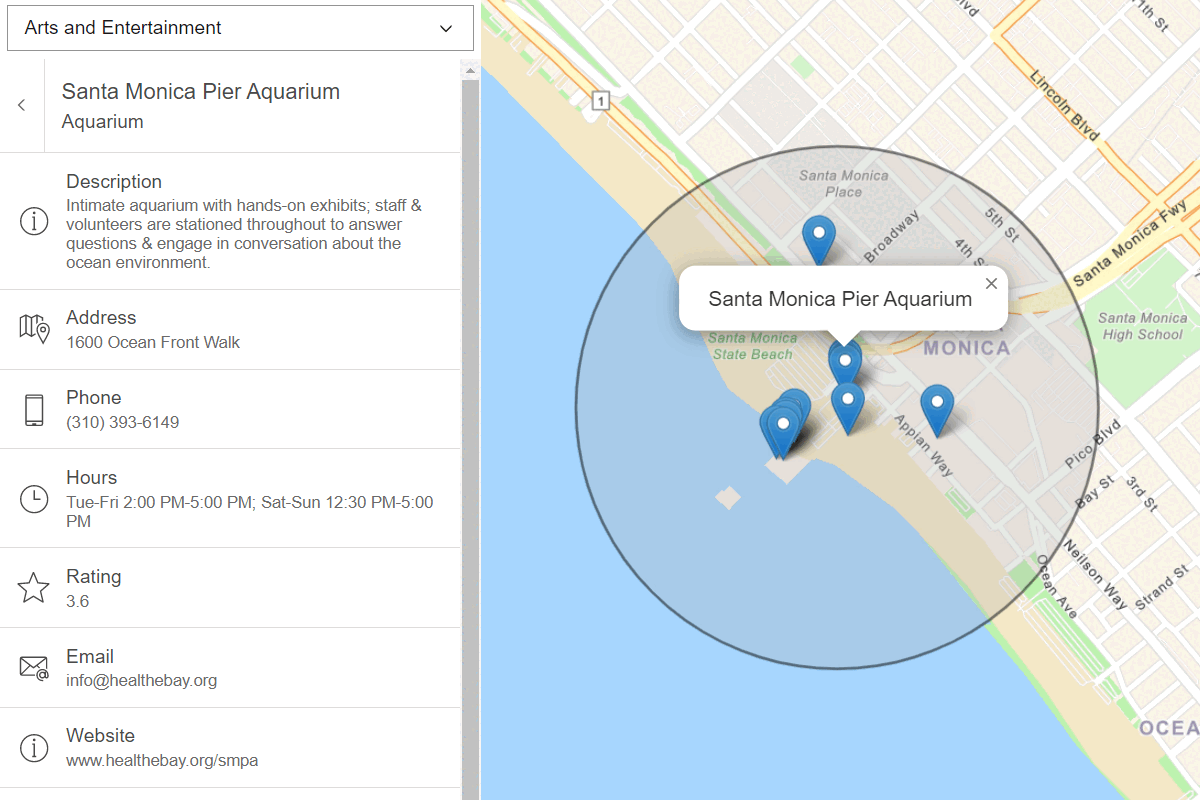Learn how to search for places of interest.
Place finding is the process of searching for a place name or POI to find its address and location. You can use the geocoding service to find places such as coffee shops, gas stations, or restaurants for any geographic location around the world. You can search for places by name or by using categories. You can search near a location or you can search globally.
In this tutorial, you use ArcGIS REST JS to access the geocoding service and find places by place category.
Prerequisites
An ArcGIS Location Platform or ArcGIS Online account.
Steps
Get the starter app
Select a type of authentication below and follow the steps to create a new application.
Set up authentication
Create developer credentials in your portal for the type of authentication you selected.
Set developer credentials
Use the API key or OAuth developer credentials so your application can access location services.
Add references to ArcGIS REST JS
This tutorial uses ArcGIS REST JS for place finding.
-
In the
<headelement, add references to the ArcGIS REST JS library.> Use dark colors for code blocks <link rel="stylesheet" href="https://cdn.jsdelivr.net/npm/ol@v10.4.0/ol.css" type="text/css" /> <script src="https://cdn.jsdelivr.net/npm/ol@v10.4.0/dist/ol.js"></script> <script src="https://cdn.jsdelivr.net/npm/ol-mapbox-style@12.3.5/dist/olms.js" type="text/javascript"></script> <script src="https://unpkg.com/@esri/arcgis-rest-request@4/dist/bundled/request.umd.js"></script> <script src="https://unpkg.com/@esri/arcgis-rest-geocoding@4/dist/bundled/geocoding.umd.js"></script>
Update the map
A navigation basemap layer is typically used in geocoding and routing applications. Update the basemap layer to use arcgis/navigation.
-
Update the basemap and the map initialization to center on location
[-122.4194,37.7749], San Francisco.Use dark colors for code blocks const view = new ol.View({ center: ol.proj.fromLonLat([-122.4194, 37.7749]), // San Francisco zoom: 14 }); map.setView(view); const basemapId = "arcgis/navigation";
Add controls
Use a select element to create the drop-down element. Each category is an option element inside it. The select element needs to have absolute positioning in order to appear in front of the map element.
-
Add a
selectcontrol, with options for "Coffee shop", "Gas station", "Food", "Hotel", "Parks and outdoors". Use inline styling to position the control.The option values have special meaning to the geocoding service so ensure the spelling is correct. To learn more, go to Category filtering in the ArcGIS services reference.
Use dark colors for code blocks <body> <div id="map"></div> <select id="places-select" style="right: 20px; top: 20px; position: absolute; font-size: 16px; padding: 4px 8px"> <option value="">Choose a place type...</option> <option value="Coffee shop">Coffee shops</option> <option value="Gas station">Gas stations</option> <option value="Food">Food</option> <option value="Hotel">Hotels</option> <option value="Parks and Outdoors">Parks and Outdoors</option> </select> -
At the top right, click Run to verify that the
selectcontrol is created and contains the different categories.
Add a places layer
To display places from the geocoding service on the map, you will add a vector layer, containing a vector source. Small blue circles is the default styling used.
-
Inside
olmsload handler, create a new vector layer containing a vector source. Store it in aplaces, and add it to the map withLayer map.add;Layer Use dark colors for code blocks olms.apply(map, basemapURL).then(function (map) { const placesLayer = new ol.layer.Vector({ source: new ol.source.Vector(), }); map.addLayer(placesLayer);
Call the geocoding service
To find places near a location, you can use the arcgis. Use the center of the map view.get with proj.to to get the point in longitude and latitude. Provide the category selected by the user using document.get to get the control, then use its value property.
-
Create a function called
show. Inside, create a newPlaces arcgisto access the geocoding service. CallRest. Api Key Manager arcgisto set the API key and to call the service endpoint. PassRest.geocode() locationandcategory, and specifyPlaceand_addr Placeas the fields to be returned. Request a maximum of 25 places.Name Use dark colors for code blocks map.addLayer(placesLayer); function showPlaces() { const authentication = arcgisRest.ApiKeyManager.fromKey(accessToken); const category = document.getElementById("places-select").value; arcgisRest .geocode({ authentication, outFields: "Place_addr,PlaceName", // attributes to be returned params: { category, location: ol.proj.toLonLat(view.getCenter()), maxLocations: 25 } }) }
Display results
When the query completes, the geo property of the response object contains a GeoJSON feature collection of points. You can use this to update the data of your places source. You will need to use a Geo feature format to read the data, and also reproject it to the map's projection. Use an exception handler to detect problems accessing the service. This could happen due to network disruption or a problem with your API key, for instance.
-
Add a response handler. Inside, use a new GeoJSON feature format to read the
geoproperty and reproject the data. Clear the places source withJson clearand add the new features withaddFeatures Use dark colors for code blocks params: { category, location: ol.proj.toLonLat(view.getCenter()), maxLocations: 25 } }) .then((response) => { const features = new ol.format.GeoJSON({ featureProjection: view.getProjection() }).readFeatures(response.geoJson); placesLayer.getSource().clear(); placesLayer.getSource().addFeatures(features); }) -
If there is an exception accessing the geocoding service, alert the user and log the error.
Use dark colors for code blocks .then((response) => { const features = new ol.format.GeoJSON({ featureProjection: view.getProjection() }).readFeatures(response.geoJson); placesLayer.getSource().clear(); placesLayer.getSource().addFeatures(features); }) .catch((error) => { alert("There was a problem using the geocoder. See the console for details."); console.error(error); });
Add a change event handler
To update the map when the user chooses a category, you must add an event handler for the change event on the <select control.
-
After the map initialization code, add
showas thePlaces changeevent handler to the<selectcontrol.> Use dark colors for code blocks .catch((error) => { alert("There was a problem using the geocoder. See the console for details."); console.error(error); }); } document.getElementById("places-select").addEventListener("change", showPlaces); -
At the top right, click Run. When you choose a place category, circles should be shown for places.
Display labels
In order to show the name of each place on the map, you will modify the layer definition to include a style property. You provide a function that takes a feature and returns a Style. It will include a Text style to display the labels, using the text property to determine which is text is displayed. Use the Place property of the feature for this. You will also set properties such as text and font to control the appearance of the labels. The style will also include a Circle style to draw a circle at the place location.
By default, the labels would overlap each other and be hard to read. You use the declutter property on the Vector layer to prevent this.
-
Add a
styleproperty to theplacesdefinition. Make this function return a newLayer Stylewhich includes aCirclestyle and aTextstyle for theimageandtextproperties. Enable thedecluttersetting.Use dark colors for code blocks const placesLayer = new ol.layer.Vector({ source: new ol.source.Vector(), style: (feature) => new ol.style.Style({ image: new ol.style.Circle({ radius: 5, fill: new ol.style.Fill({ color: "white" }), stroke: new ol.style.Stroke({ color: "hsl(220, 80%, 40%)", width: 2 }) }), text: new ol.style.Text({ font: "14px sans-serif", textAlign: "left", text: feature.get("PlaceName"), offsetX: 8, // move text to the right to avoid overlapping circle offsetY: 2, // move down to align with circle's center fill: new ol.style.Fill({ color: "hsl(220, 80%, 40%)" }), stroke: new ol.style.Stroke({ color: "white" }) }) }), declutter: true
Run the app
Run the app.
When you choose a place category, you should see the name of each place shown as a label, next to a white circle with a blue outline.
What's next?
Learn how to use additional ArcGIS location services in these tutorials:


